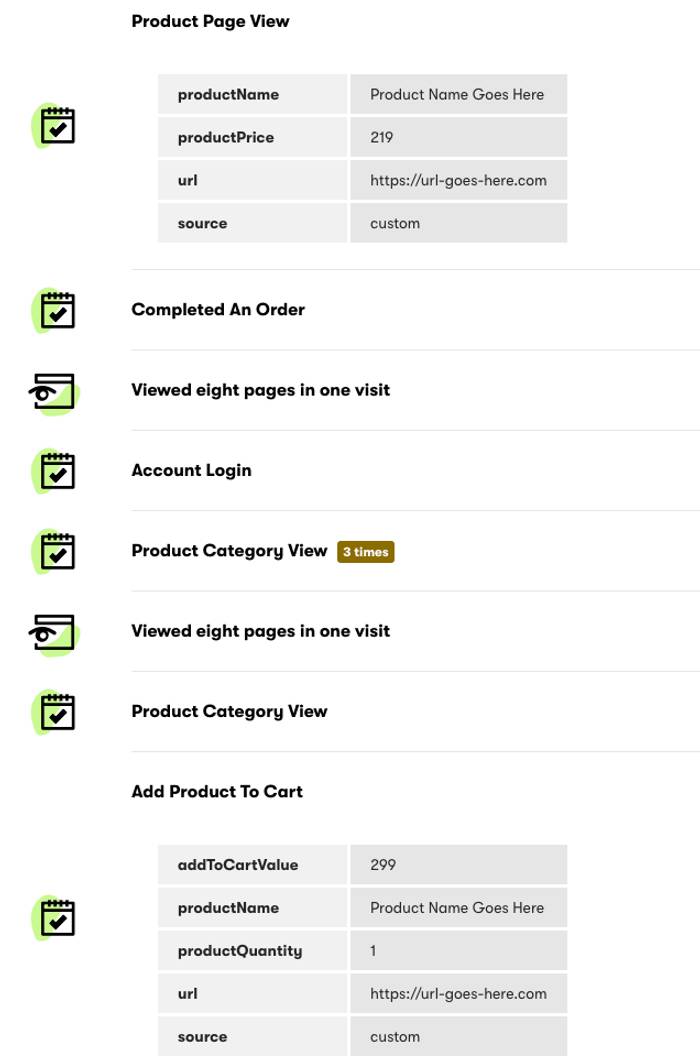Data segmentation - why should I bother?
In short, it’s a way of breaking your customer base down into more manageable, focused groups of people based on common traits and behaviours. For example, if you own a clothing brand, could break your customers down via gender, age group, location and preferred size, so that you’re not sending lingerie to males over 50 who have never purchased this type of item before and can’t buy it at their local store.
You can take this a step further and build segments based around behavioural traits, which includes monitoring their engagement and behaviour online earlier on in the customer journey. For example, you may know that Bob has purchased five pairs of jeans before from his local Leeds store - which is great, but by adding an extra layer of behavioural segmentation on top of that, you could also identify that Bob also keeps looking at a particular coat on your website, but hasn’t yet purchased it because it’s out of stock in his local store.
Voila! You now have a new opportunity to capture an extra sale that you wouldn’t have known about before. In this case, you could then market to Bob making him aware that the product is in fact in stock at the York store, just 15 miles away, or alternatively, you can order it from the York store to be delivered straight to his front door. Or, you could even make Bob aware of a very similar coat as an alternative that is in stock, and give him a financial incentive as a reward for being loyal and buying five pairs of jeans previously.
“The best campaigns are often built on top of a data rich databases. Therein lies the importance of data segmentation and profiling.”
The challenges
The biggest challenges we usually face when looking to implement any form of behavioural marketing usually falls into two areas; poor data and/or lack of it, or lack of insight and understanding of how to interpret your data to help segment your customers. This article is going to cover the latter.
The best campaigns are often built on top of a data rich databases. Therein lies the importance of data segmentation and profiling. Segmentation should be a major focus for businesses in general, but particularly in the case of email and social marketing. Targeting the wrong people with the wrong message can be incredibly damaging to a brand, which will naturally result in higher opt-outs and ultimately a reduction in revenue.
It follows the same principles as many other channels. The best results across any medium are when you provide a solution based on a customers intent. In the case of SEO and content for example, a good article is often geared around a question that users are commonly searching for, and struggling to find an answer. Relevance and intent driven decisions are key when implementing a marketing campaign, and the same discipline applies to email marketing.
The current problem with segmentation, or lack of, is most companies lack the capabilities for analysing data to find opportunities, create relevancy and ultimately find the answer to ‘when and how are our customers interacting with our business on and offline?’.
A vacuum of insight and understanding of customer behaviour tends to mean we rely on other data points and client analysis, which isn’t always available, isn’t a quick process and doesn’t always lead to a positive increase in engagement and sales - as it’s largely speculative.
So what’s the solution?
Commit to investing time to sort out your data. This isn’t something that is going to happen overnight, especially on large data sets. Try and break it down into the following steps:
Identify your core audiences
You should already know this, but identifying exactly who your customers are is paramount to successfully marketing your product. You may have more than one audience, which is common if you’ve got a larger product range, but either way, be clear on who you want to reach.
Identify how you distinguish between these audiences
This will help form the basis of what information you need to collect. For example, if you sell items for different age groups, you need to know their age. If you only sell your products in certain locations, you need to know where your customers are based.
If your core audiences are based on specific types of products, then you also need to identify what products customers have already bought, and also which ones they’re showing interest in to help you inform future trends for each individual.
By the time you’re finished, you should have a long list like this:
- Gender
- Age
- Location / nearest physical store
- Purchase history
- Recently viewed products
- Abandoned carts
- Purchase location - are they buying online or instore
- Name
- DOB
- Recently viewed pages
- Goals and events per person
- The list goes on...
Capture the information
Once you know what information you need to build your segments, the next stage is to figure out how to capture it and store it. This can be done with a range of platforms such as Segment or Drip, which allow you to track onsite engagement such as page views, add to carts, abandoned carts etc, store them to a database or ECRM and then tie them back to specific user profiles.
Actually implementing this kind of data capture is where an agency like Extreme comes in - of course this can be done yourself if you have the relevant resources, but our team have got lots of experience doing this kind of work.
Once you know all this information, you’ll soon have a rich profile for each of your customers that you can use to personalise their content, based on their own behaviour. Below is a simple snapshot of the kind of information you can capture on an ecommerce site:
Now it’s time to use your new data to build segments and start workflows
You’re nearly there! Now you’ve got all this information, it’s time to start using it to create behavioural workflows and automations for your customers based on their engagement. This is where the real fun starts and where you start to reap the benefits of all the time you’ve invested so far.
Our next article, part three will cover how you can use automations and workflows to increase engagement and minimise manual input, to provide a better personalised experience for your customers that will ultimately increase ROI.
Fancy a good ol' chat about the values of marketing to your business?
Drop Us a LinePost by
Project




